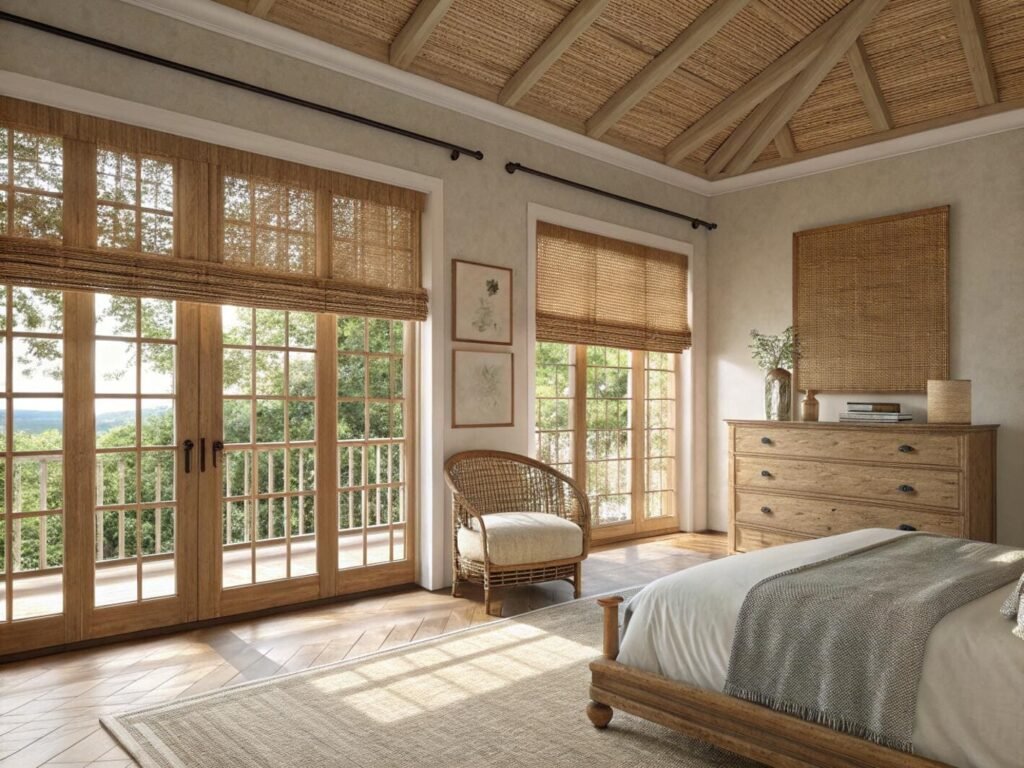Natural materials create stunning interiors but bring hidden challenges. Warping happens. Fading occurs. Maintenance demands multiply unexpectedly.
Bamboo and woven wood shades offer superior aesthetics and sustainability, while traditional blinds provide better durability and smart integration. The best choice depends on your project priorities and environmental conditions.
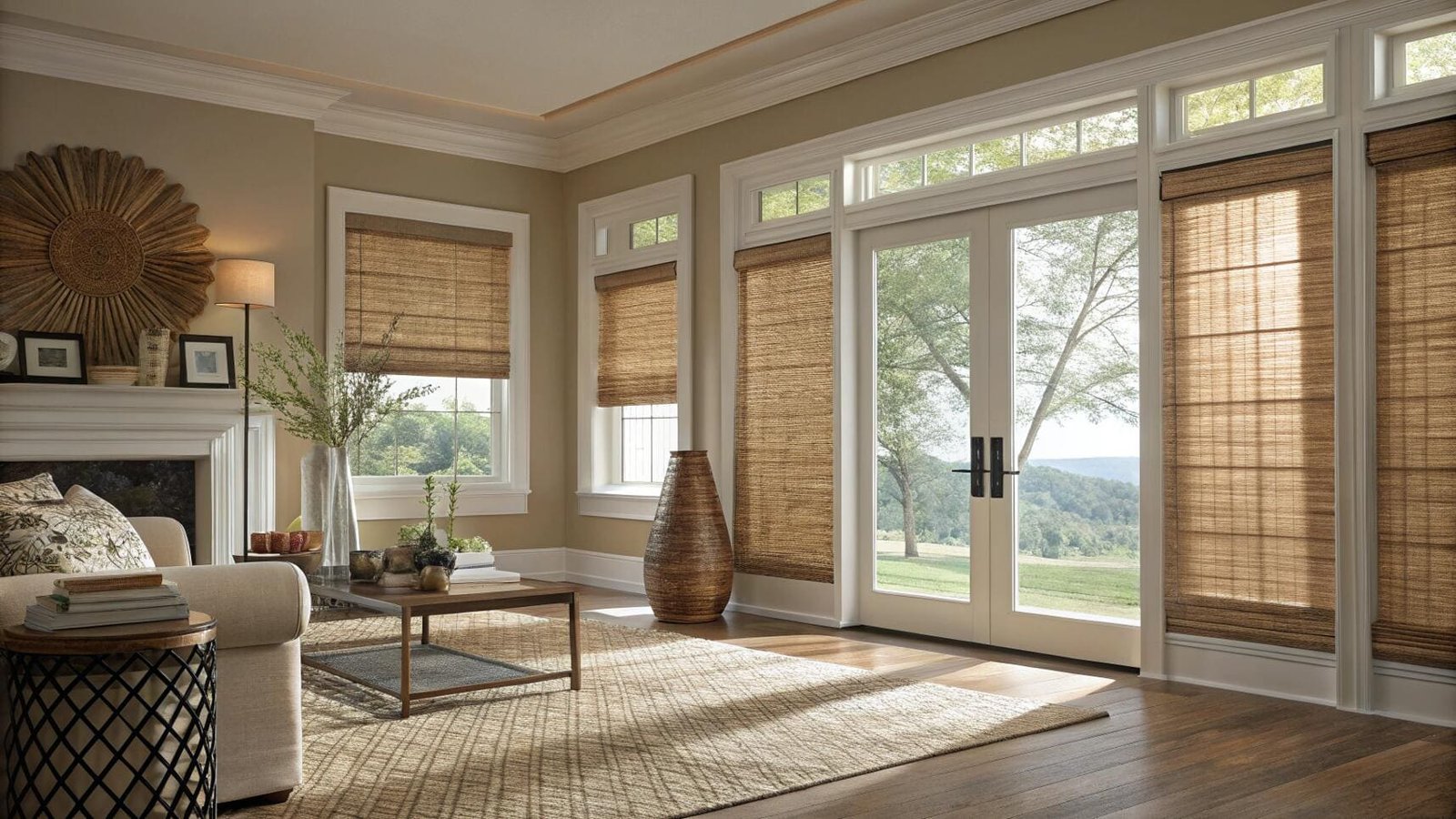
After working with both natural and synthetic materials across hundreds of projects, I’ve learned that material choice shapes everything from installation complexity to long-term client satisfaction[^1]. The right selection creates spaces clients love for decades.
What is the difference between bamboo and woven wood shades?
Material confusion creates specification errors. Bamboo and woven wood sound similar but perform differently. Understanding these differences prevents costly project mistakes.
Bamboo shades use fast-growing grass fibers for lightweight, flexible operation. Woven wood shades combine hardwood slats with decorative fibers for enhanced durability and varied textures.
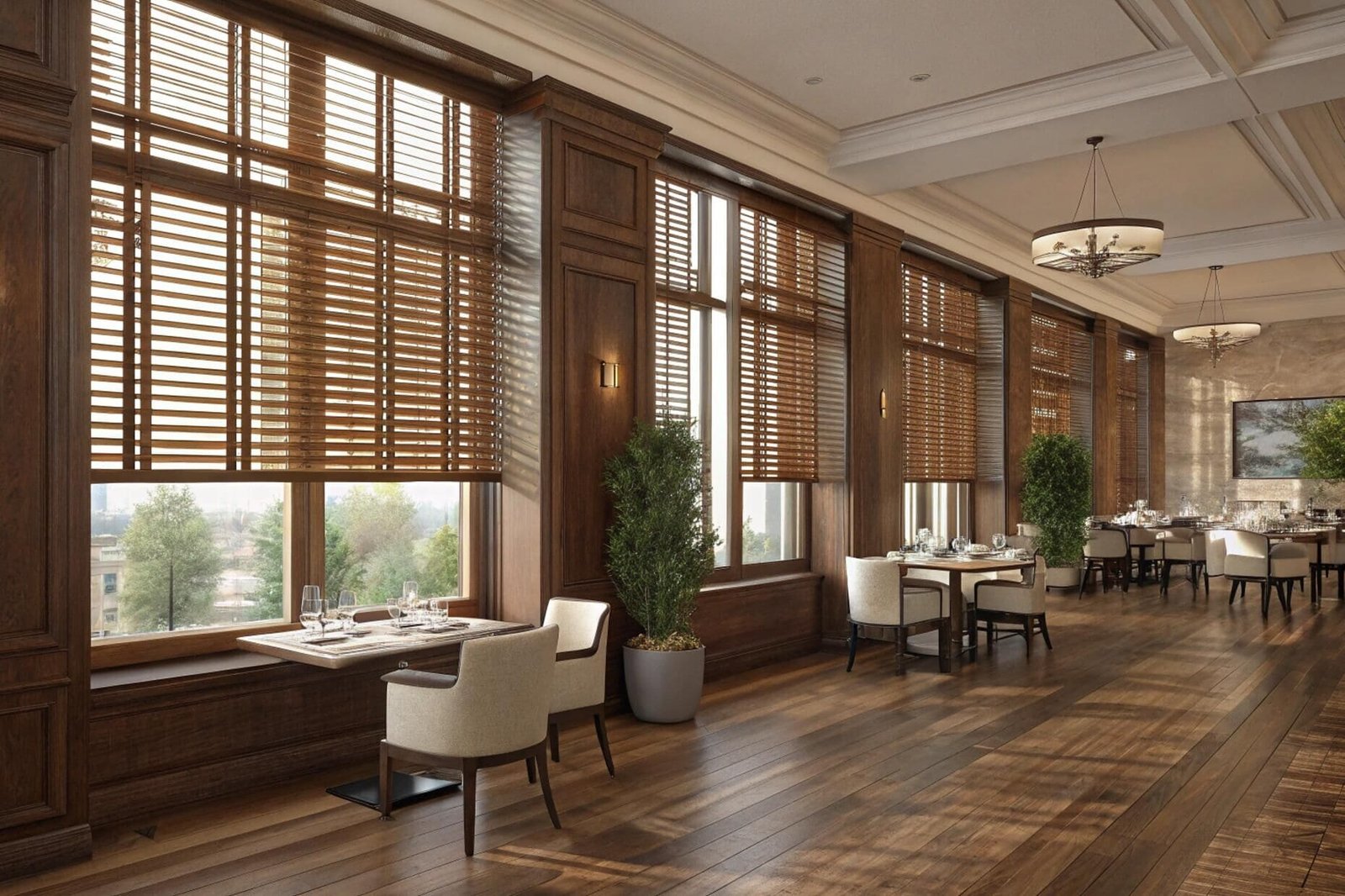
From my manufacturing experience, the construction methods create distinct performance characteristics. Bamboo shades typically use thin bamboo strips woven with cotton or polyester threads. This creates lightweight panels that operate smoothly but may lack structural strength[^2] for large openings. The natural bamboo provides excellent light filtering and creates warm, organic aesthetics that clients love.
Woven wood shades combine the best of both worlds. They use hardwood slats as the structural foundation, then weave in decorative elements like bamboo, grass, or synthetic fibers. This hybrid construction provides the durability needed for commercial applications while maintaining natural aesthetics. The hardwood backbone prevents sagging and ensures consistent operation across wide spans.
Manufacturing quality varies significantly between suppliers. Premium bamboo shades use kiln-dried materials and reinforced edge binding. Budget options often skip these steps, leading to premature failure. I always specify UV-treated bamboo[^3] to prevent color fading and fiber degradation in high-sun exposures.
Construction Comparison
| Feature | Bamboo Shades | Woven Wood Shades |
|---|---|---|
| Primary Material | Bamboo grass strips | Hardwood slats + woven elements |
| Weight | 0.5-0.8 lbs/sqft | 0.8-1.2 lbs/sqft |
| Max Width | 72 inches | 96 inches |
| Structural Strength | Moderate | High |
| Texture Variety | Limited | Extensive |
Which blinds are better, wood or faux wood?
Material choice impacts performance, cost, and longevity. Real wood provides natural beauty but requires careful environmental consideration. Faux wood delivers consistency but may lack aesthetic warmth.
Faux wood blinds outperform real wood in moisture resistance and cost-effectiveness, while real wood excels in aesthetics and thermal performance. Project location and budget determine the optimal choice.
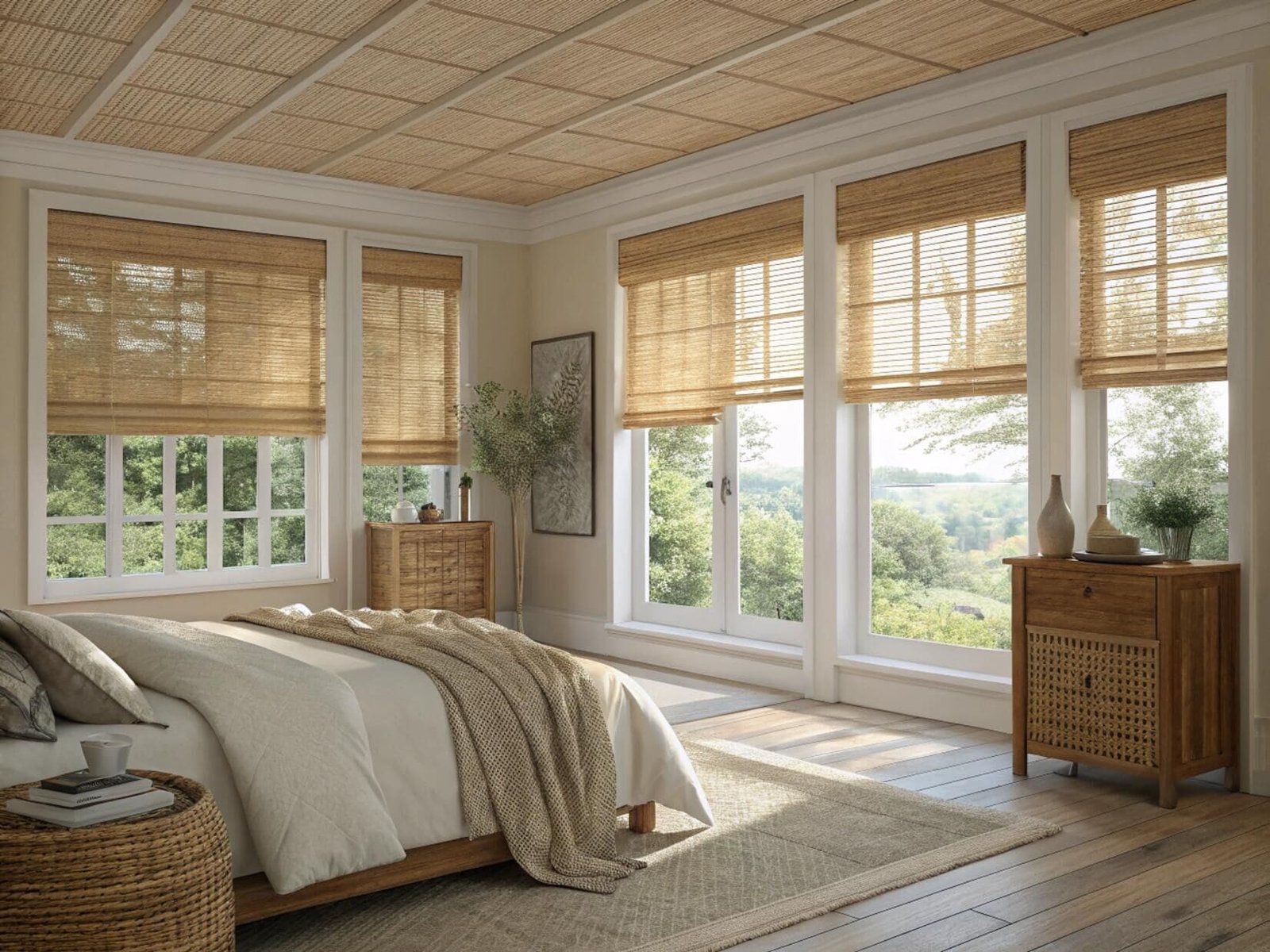
Through years of project installations, I’ve observed distinct performance patterns. Real wood blinds create unmatched warmth and natural beauty. The grain patterns and color variations make each installation unique. However, moisture sensitivity[^4] limits their application – I never recommend real wood in bathrooms, kitchens, or high-humidity environments. Warping and splitting become inevitable problems.
Faux wood blinds solve the moisture problem completely. Modern PVC and composite materials resist humidity, temperature changes, and UV exposure. They maintain consistent operation and appearance across all environments. The latest generations achieve remarkably realistic wood grain patterns that satisfy most aesthetic requirements.
Cost considerations often drive final decisions. Real wood blinds typically cost 40-60% more than equivalent faux wood options. However, the price gap narrows for premium faux wood products with advanced grain patterns and textures. Installation complexity remains similar for both materials.
Performance Matrix
Real Wood Advantages:
- Authentic natural beauty and grain patterns
- Superior thermal insulation properties
- Potential for refinishing and color changes
- Premium market positioning
Faux Wood Advantages:
- Complete moisture and humidity resistance
- Consistent dimensional stability
- 30-50% lower material costs
- Easier cleaning and maintenance
Which type of blinds last the longest?
Longevity depends on material quality, environmental conditions[^5], and usage patterns. Different blind types excel in specific applications. Understanding lifespan expectations prevents premature replacement costs.
Aluminum venetian blinds and quality cellular shades offer 15-20 year lifespans with proper maintenance. Wood blinds last 10-15 years in suitable environments, while bamboo shades typically require replacement after 7-10 years.
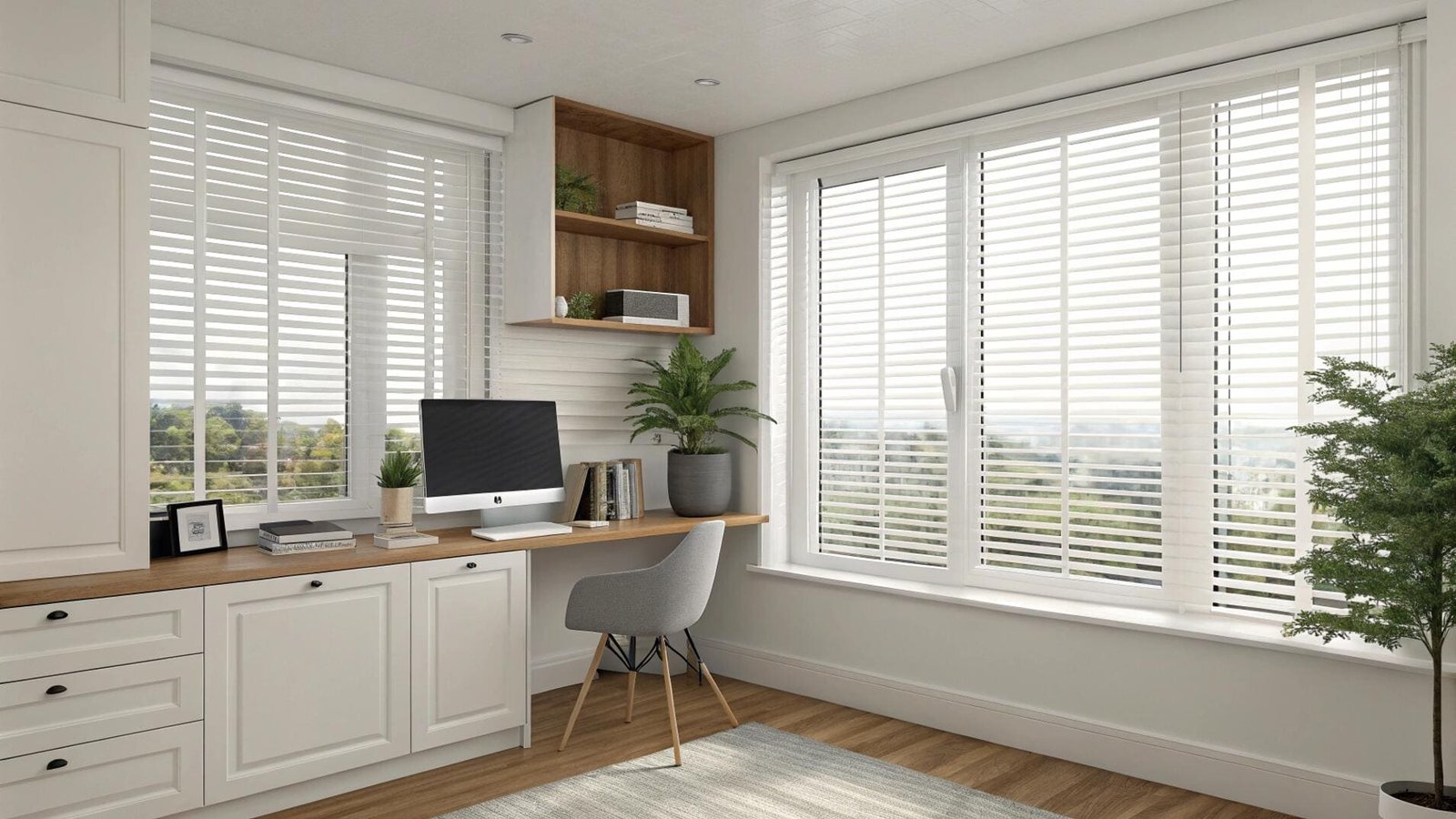
My experience with long-term installations reveals clear durability patterns. Aluminum venetian blinds consistently deliver the longest service life. The metal construction resists UV damage, moisture, and mechanical wear. I’ve seen quality aluminum blinds operate smoothly after 20+ years with minimal maintenance. The key is proper powder coating that prevents corrosion and color fading.
Cellular shades surprise many with their longevity when properly manufactured. The honeycomb structure distributes stress evenly, preventing tearing and sagging. Premium fabrics with UV protection maintain color and integrity for 15+ years. However, budget cellular shades often fail within 5-7 years due to inferior materials and construction.
Wood blind longevity depends heavily on environmental conditions. In climate-controlled interiors with moderate humidity, quality wood blinds easily achieve 15-year lifespans. However, thermal cycling and humidity fluctuations accelerate wear. Regular maintenance including cleaning and periodic re-oiling extends wood blind life significantly.
Expected Lifespan by Type
| Blind Type | Average Lifespan | Optimal Conditions | Limiting Factors |
|---|---|---|---|
| Aluminum Venetian | 15-20 years | Any interior | Mechanism wear |
| Cellular Shades | 12-18 years | Moderate sun | Fabric degradation |
| Wood Blinds | 10-15 years | Stable humidity | Moisture damage |
| Faux Wood | 12-16 years | Any interior | UV exposure |
| Bamboo/Woven Wood | 7-12 years | Low humidity | Natural aging |
What are the disadvantages of bamboo shades?
Natural materials bring inherent limitations. Bamboo’s organic nature creates maintenance challenges and performance constraints. Understanding these drawbacks prevents project disappointments.
Bamboo shades suffer from limited light control, moisture sensitivity, and natural aging that affects appearance and operation. They also lack smart control integration and may require frequent cleaning in high-dust environments.
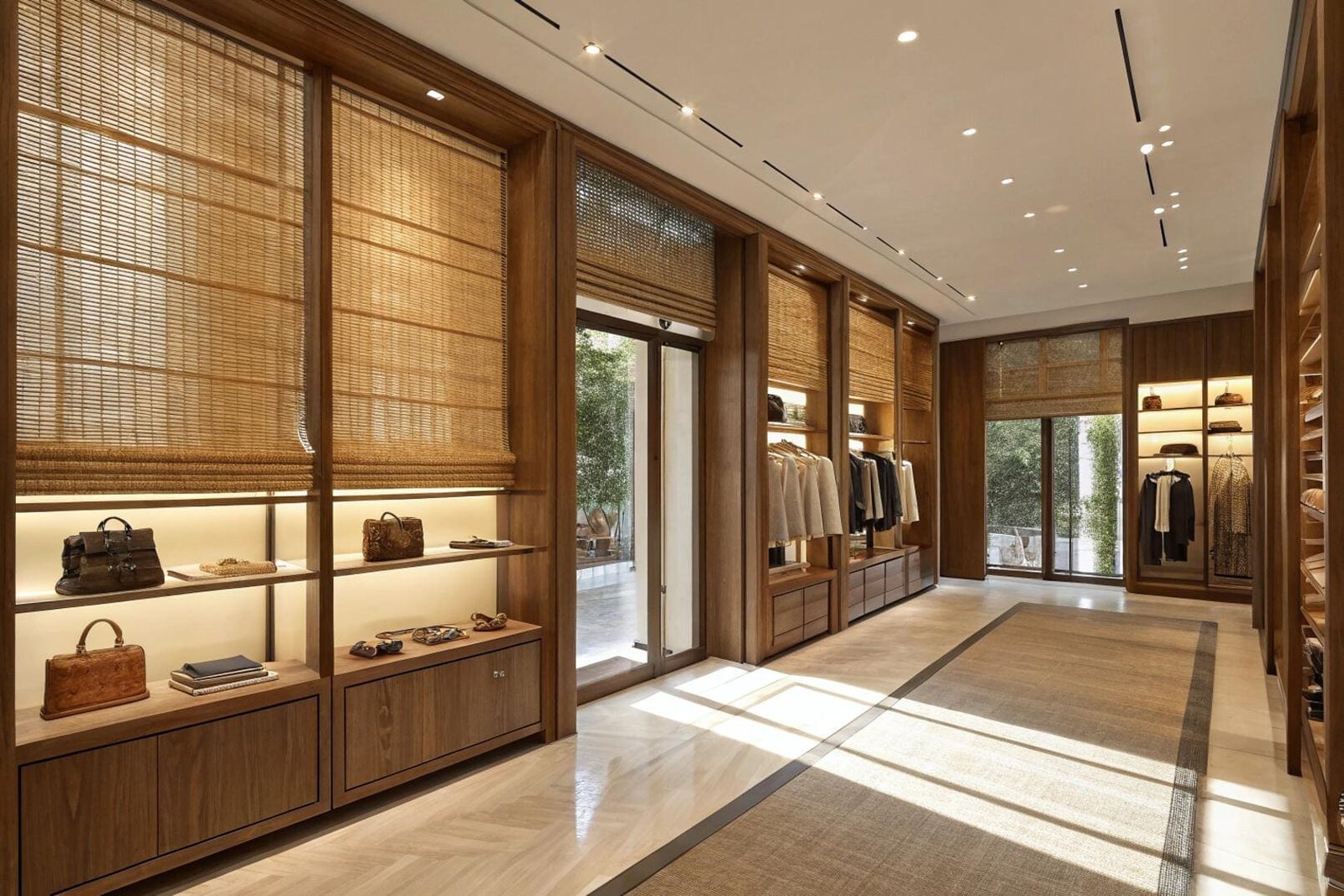
The biggest limitation I encounter with bamboo shades is light control precision. The woven construction creates gaps that allow light leakage, making them unsuitable for bedrooms or media rooms requiring blackout conditions. Even tightly woven bamboo allows significant light transmission compared to conventional blinds with overlapping slats.
Moisture sensitivity creates ongoing concerns. Bamboo naturally expands and contracts with humidity changes. This movement can cause binding in the operating mechanism and uneven hanging. I’ve seen bamboo shades develop permanent waves and distortions in high-humidity environments. Kitchen and bathroom installations often fail within 2-3 years due to moisture exposure.
Natural aging affects both appearance and performance. UV exposure gradually bleaches bamboo fibers, creating uneven coloration. The organic materials also attract dust and may harbor allergens or insects in certain environments. Cleaning becomes challenging because moisture can damage the natural fibers, yet dry cleaning methods often prove insufficient for thorough maintenance.
Smart integration presents the biggest obstacle for modern projects. Most bamboo shade manufacturers don’t offer motorized options due to the material’s irregular weight distribution and natural variations. This limitation eliminates automated control possibilities that clients increasingly expect in premium installations.
Key Limitations Summary
Light Control Issues:
- Significant light leakage through woven construction
- Impossible to achieve true blackout conditions
- Limited privacy in evening with interior lighting
Environmental Sensitivity:
- Warping and distortion in high humidity
- Color fading from UV exposure
- Potential mold or mildew in damp conditions
Operational Constraints:
- Limited motorization options
- Mechanical binding from material movement
- Difficult cleaning and maintenance requirements
How do modern cellular and zebra shades compare to traditional woven wood options?
Modern shade technologies offer enhanced functionality while natural materials provide timeless aesthetics. Performance differences affect user experience and long-term satisfaction. The choice impacts both initial investment and ongoing maintenance.
Cellular and zebra shades excel in energy efficiency and light control precision, while woven wood shades provide superior natural aesthetics and texture. Modern options integrate smart controls easily, unlike traditional natural materials.
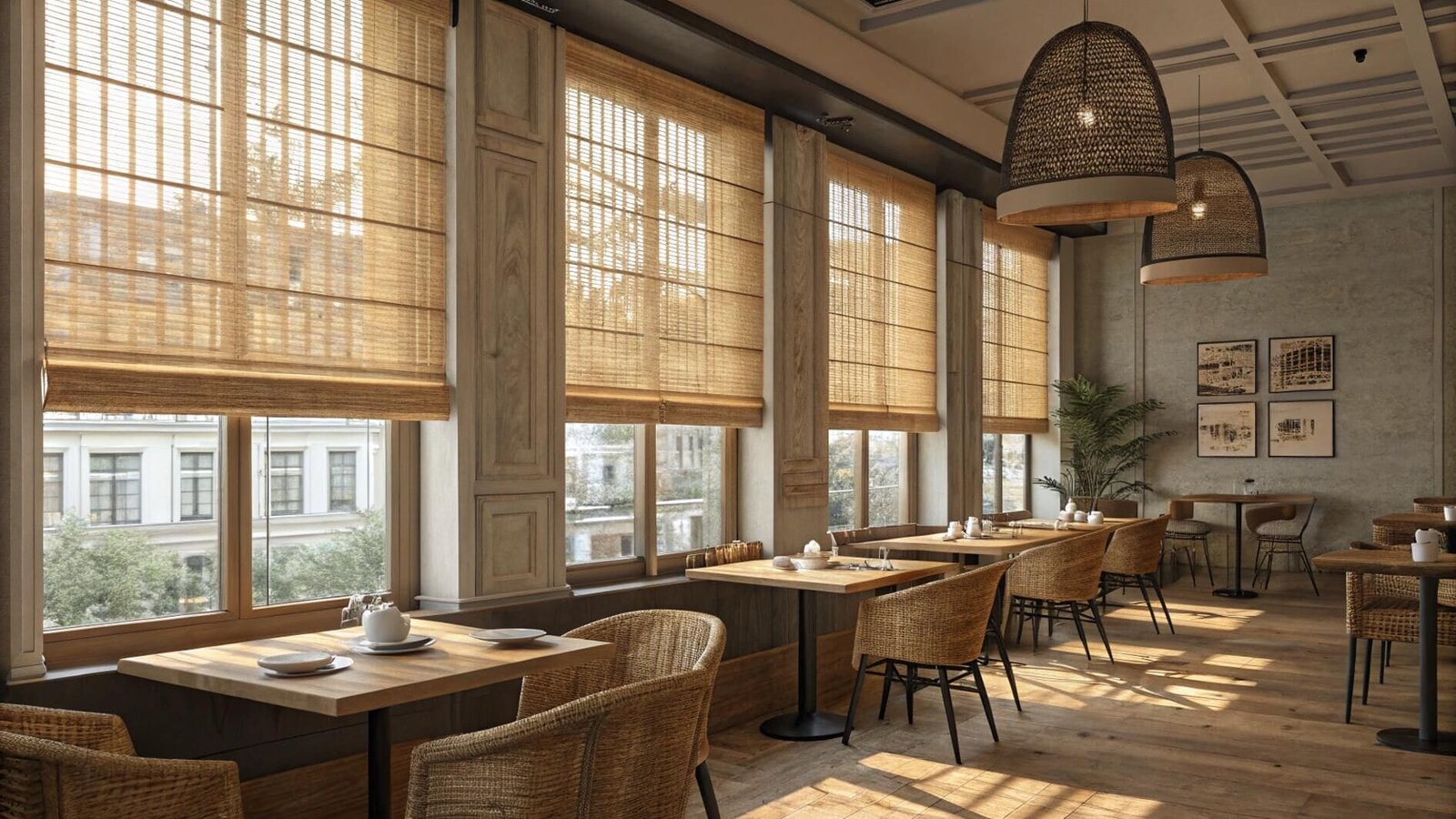
The technology gap between modern and traditional shades has widened significantly. Cellular shades achieve R-values of 3-5, providing substantial insulation benefits that reduce energy costs. The honeycomb structure traps air, creating thermal barriers that woven wood cannot match. In my experience, cellular shades can reduce cooling costs by 15-25% in large window applications.
Zebra shades revolutionize light control through their dual-fabric design. Alternating sheer and opaque bands allow infinite adjustment between full privacy and maximum light transmission. This precision eliminates the compromise inherent in woven wood shades, which provide fixed light filtering with limited adjustment options.
Operation smoothness favors modern designs. Cellular and zebra shades use precision-engineered lift systems with consistent weight distribution. Woven wood shades often develop operational issues as natural materials age and change dimensions. The irregular weight distribution in woven wood can cause binding and uneven movement over time.
Smart integration capabilities create the biggest performance gap. Modern shades readily accept motorization with reliable operation. Battery-powered systems eliminate wiring complexity while providing smartphone control and automated scheduling. Traditional woven wood shades require custom motorization solutions that often prove unreliable due to material inconsistencies.
Technology Comparison Matrix
| Feature | Cellular Shades | Zebra Shades | Woven Wood |
|---|---|---|---|
| Energy Efficiency | Excellent (R-3 to R-5) | Good (R-1.5 to R-2.5) | Fair (R-1 to R-1.5) |
| Light Control Precision | Good | Excellent | Limited |
| Smart Integration | Excellent | Excellent | Poor |
| Natural Aesthetics | Poor | Fair | Excellent |
| Durability | Excellent | Good | Fair |
| Maintenance | Low | Low | High |
What are the maintenance requirements for natural vs synthetic window treatments?
Maintenance demands vary dramatically between material types. Natural materials require specialized care and regular attention. Synthetic options offer simplified maintenance but need proper cleaning techniques for optimal longevity.
Natural treatments require monthly dusting, annual deep cleaning, and humidity control to prevent damage. Synthetic treatments need only quarterly cleaning with standard methods and occasional mechanism lubrication.
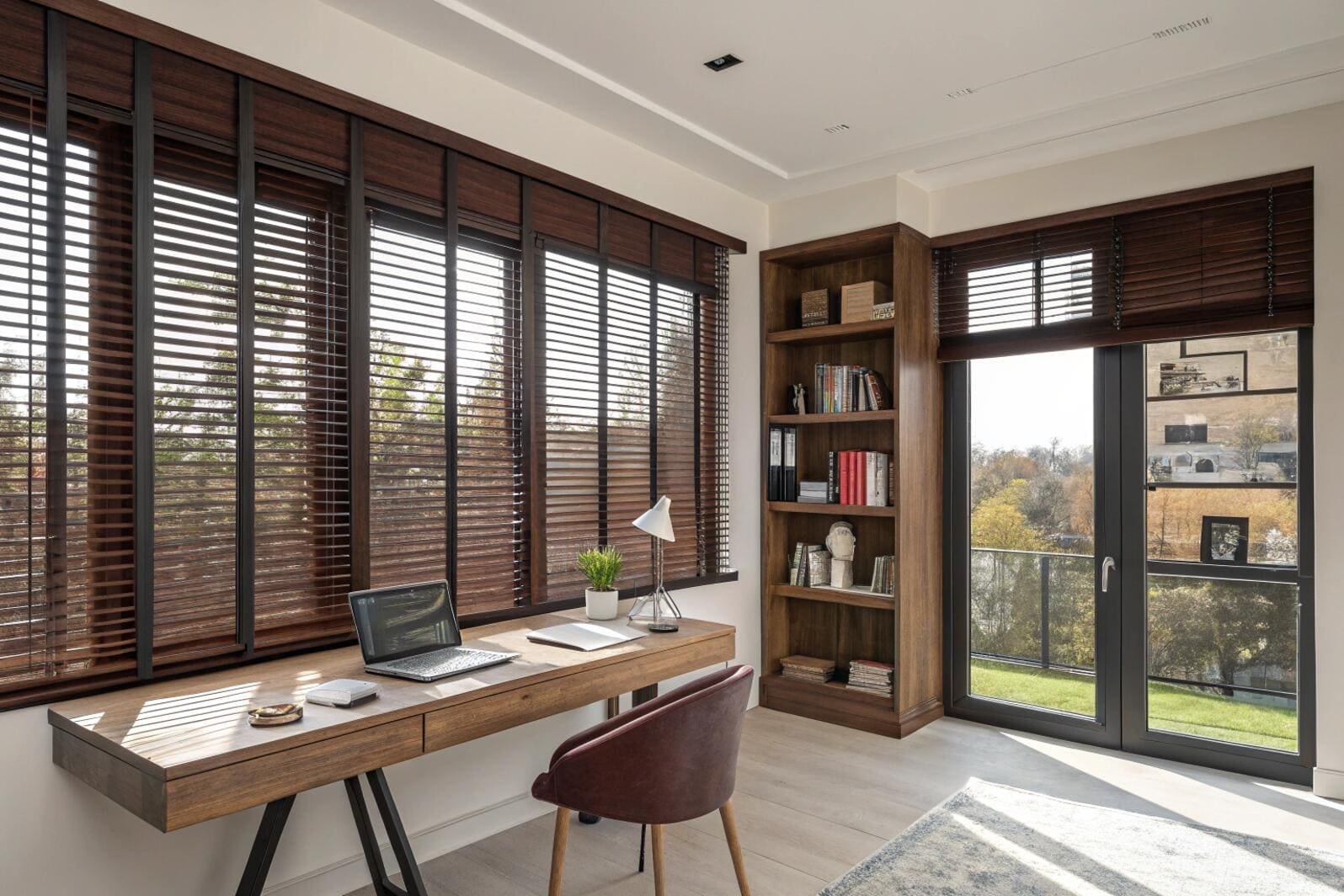
Natural material maintenance becomes a significant ongoing cost factor. Bamboo and woven wood shades accumulate dust in their textured surfaces, requiring careful vacuuming with brush attachments. I recommend monthly maintenance to prevent buildup that becomes difficult to remove. Deep cleaning requires professional services using specialized techniques that won’t damage natural fibers.
Humidity control proves critical for natural materials. Excessive moisture causes warping, while low humidity leads to cracking and splitting. I always recommend maintaining 40-60% relative humidity in rooms with natural window treatments. This often requires additional humidification or dehumidification equipment.
Synthetic materials dramatically reduce maintenance demands. Aluminum, vinyl, and fabric cellular shades resist dust accumulation and clean easily with damp cloths. The smooth surfaces don’t harbor allergens or require specialized treatments. Most synthetic blinds maintain appearance and function with quarterly cleaning sessions.
Motorized systems add maintenance considerations regardless of material type. Battery replacement becomes necessary every 1-2 years for battery-powered systems. Mechanical components require occasional lubrication and adjustment. However, motorization often extends blind life by reducing manual handling and operation stress.
Annual Maintenance Cost Comparison
Natural Materials (Bamboo/Woven Wood):
- Monthly dusting: 2-3 hours
- Quarterly deep cleaning: $150-250 professional service
- Annual humidity control: $200-400 equipment costs
- Repair/replacement: 15-20% higher frequency
Synthetic Materials:
- Quarterly cleaning: 30 minutes self-service
- Annual mechanism service: $50-100 if motorized
- Repair needs: Minimal until 10+ years
Which window treatment materials offer the best energy efficiency performance?
Energy performance directly impacts operating costs and occupant comfort. Different materials provide varying levels of insulation and solar control. Understanding thermal properties guides optimal selection for energy-conscious projects.
Triple-cell cellular shades deliver the highest energy efficiency with R-values up to 5.0, followed by insulated cellular designs. Traditional materials like wood and bamboo provide minimal thermal benefits compared to engineered fabric systems.
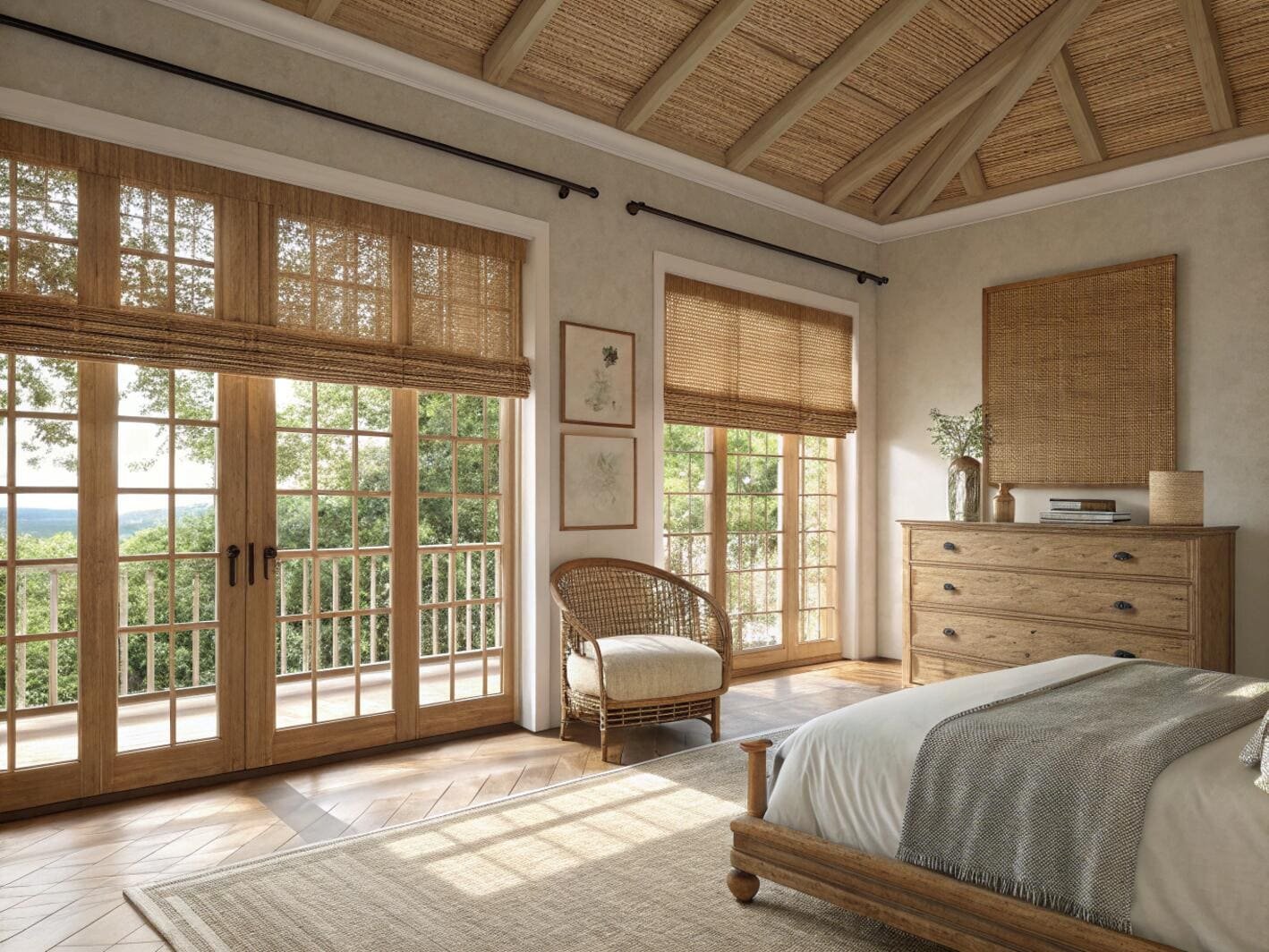
The physics of thermal performance favor engineered solutions over natural materials. Cellular shades create dead air spaces that function like insulated wall cavities. Single-cell designs achieve R-2, double-cell reaches R-3.5, and triple-cell systems approach R-5. These values rival traditional wall insulation and can reduce window heat loss by 70-80%.
Reflective technologies multiply energy benefits significantly. Metallized fabrics reflect up to 95% of solar radiation while maintaining interior views. Low-E coatings work similarly to energy-efficient glazing systems. These advanced materials cost 20-30% more than standard fabrics but typically pay for themselves through energy savings within 3-5 years.
Natural materials provide minimal thermal benefits due to their open construction and thin profiles. Bamboo and woven wood shades typically achieve R-values of 0.5-1.0, comparable to adding another pane of glass. While this provides some benefit, it pales compared to engineered alternatives.
Smart controls amplify energy performance through automated optimization. Sun-tracking systems adjust blind position throughout the day to maximize winter heat gain and minimize summer cooling loads. Temperature sensors trigger adjustments based on thermal conditions. Integration with HVAC systems creates compound savings through coordinated operation.
Thermal Performance Rankings
| Material/System | R-Value | Solar Heat Gain Reduction | Annual Energy Savings |
|---|---|---|---|
| Triple-Cell Cellular | 4.5-5.0 | 85-90% | 25-35% |
| Double-Cell Cellular | 3.0-3.5 | 75-80% | 20-25% |
| Aluminum Venetian (reflective) | 2.0-2.5 | 70-85% | 15-20% |
| Wood Blinds | 1.5-2.0 | 50-60% | 10-15% |
| Bamboo/Woven Wood | 0.5-1.0 | 30-40% | 5-10% |
How do smart motorized options enhance both natural and conventional blinds?
Smart motorization transforms static window treatments into responsive systems. Integration capabilities vary between material types. Proper system selection ensures reliable operation and future expandability across different blind materials.
Motorized systems excel with conventional blinds through precise control and reliable operation, while natural materials present integration challenges due to weight variations and material inconsistencies. Smart controls deliver maximum benefits with engineered shade systems.
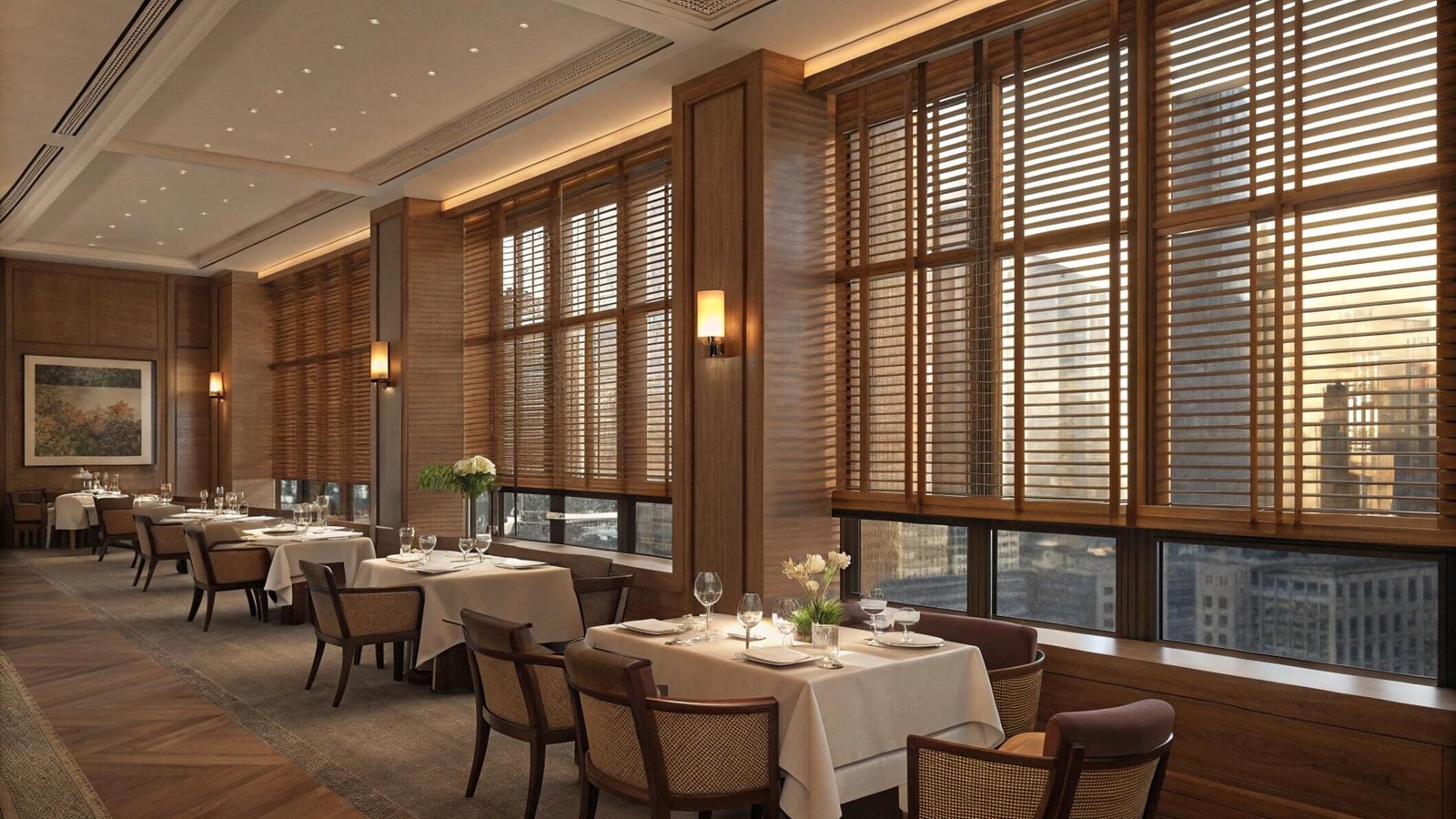
The compatibility between motorization and blind materials creates distinct performance tiers. Cellular shades and aluminum venetians integrate seamlessly with motorized systems. Their consistent weight distribution and predictable operation patterns allow precise motor calibration. I’ve installed hundreds of motorized cellular shades with virtually zero operational issues after proper setup.
Conventional blinds benefit enormously from smart integration. Automated scheduling eliminates manual operation while extending product life by reducing wear. Sun tracking systems optimize energy performance throughout the day. Voice control through Alexa or Google provides convenient operation for users of all ages and abilities.
Natural materials present significant motorization challenges. Bamboo and woven wood shades have irregular weight distribution that confuses motor calibration systems. Seasonal material movement from humidity changes can bind motors or create operational inconsistencies. Most manufacturers don’t offer motorized options for natural materials due to these reliability concerns.
Battery technology has revolutionized motorized blind installation. Lithium-ion systems operate for 6-12 months between charges, eliminating hardwiring requirements. Solar charging options provide indefinite operation for sun-exposed windows. These advances make motorization practical for existing installations and new construction alike.
Smart hub integration creates ecosystem benefits that multiply individual blind performance. Coordinated operation with lighting and HVAC systems optimizes energy usage automatically. Scene programming allows instant adjustment for different activities – work, entertainment, or sleep modes. Security integration can simulate occupancy patterns when homeowners travel.
Motorization Compatibility Assessment
Excellent Compatibility:
- Cellular shades: Consistent operation, reliable calibration
- Aluminum venetians: Precise control, long motor life
- Roller shades: Smooth operation, minimal maintenance
Good Compatibility:
- Faux wood blinds: Generally reliable with quality motors
- Fabric roman shades: Adequate performance with proper setup
Poor Compatibility:
- Natural bamboo: Weight inconsistencies, binding issues
- Woven wood: Material movement, calibration problems
- Heavy wood blinds: Motor strain, reduced lifespan
Conclusion
Modern engineered materials outperform natural options in durability, energy efficiency, and smart integration while natural materials excel in aesthetics and sustainability.
Transform Your Projects with the Right Material Choice
Your clients deserve window treatments that deliver both performance and style. Stop compromising between natural beauty and modern functionality.
Get professional-grade cellular shades, premium venetian blinds, and smart motorized systems engineered for superior performance. Access detailed material specifications, energy performance data, and smart integration guides for your next project.
Request comprehensive project specifications today:
- Material performance comparisons within 4 hours
- Energy efficiency calculations for specific applications
- Smart control system compatibility assessments
- Competitive wholesale pricing for qualified projects
Don’t let material selection challenges delay your project delivery. Partner with VelaBlinds for reliable solutions, transparent specifications, and materials that exceed client expectations.
Email: info@velablinds.com | WhatsApp: +86 13720128317
---
[^1]: Discover how the right material choice can enhance client satisfaction over time.
[^2]: Find out how the structural integrity of these materials affects their performance.
[^3]: Understand the significance of UV treatment in prolonging the life of bamboo shades.
[^4]: Discover how moisture can impact bamboo shades and what to consider for your space.
[^5]: Explore how different environments can impact the durability of your window treatments.Partner with VelaBlinds for Your Next Project
Smart window treatments shouldn’t be complicated. After working with 500+ distributors and contractors worldwide, I’ve streamlined the process to get you quality products, competitive pricing, and reliable support – every time.
Why project professionals choose VelaBlinds:
- ✅ Fast, Accurate Quotes – Detailed specs and pricing within 24 hours
- ✅ Transparent Pricing – No hidden fees, volume discounts clearly outlined
- ✅ Quality Assurance – Direct partnerships with certified OEM manufacturers
- ✅ Project Support – Dedicated account manager from quote to delivery
Start your next project:
📧 Quick Quote: Send your requirements to info@velablinds.com
📱 Direct Contact: WhatsApp +86 137 2012 8317
🌐 Browse Solutions: https://velablinds.com/
📁 Product Resources: Access spec sheets, catalogs & project files
Jimmy Chen, Founder
"I built VelaBlinds to solve the real challenges I faced as a project buyer – long lead times, unclear specs, and unreliable suppliers. Let’s discuss how we can power your projects with smarter blinds."
Serving distributors and contractors across North America, Europe, and Australia since 2018.

